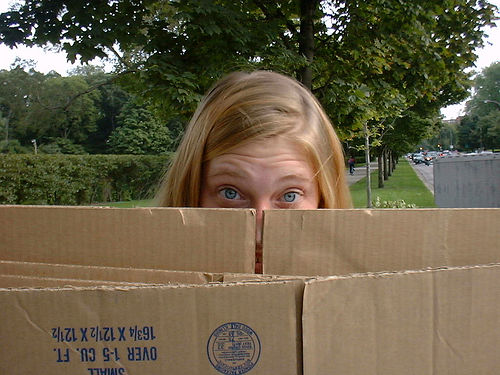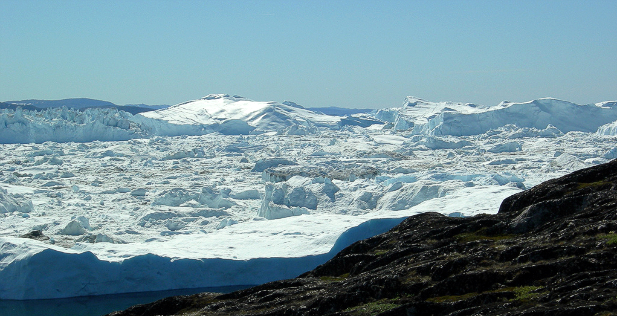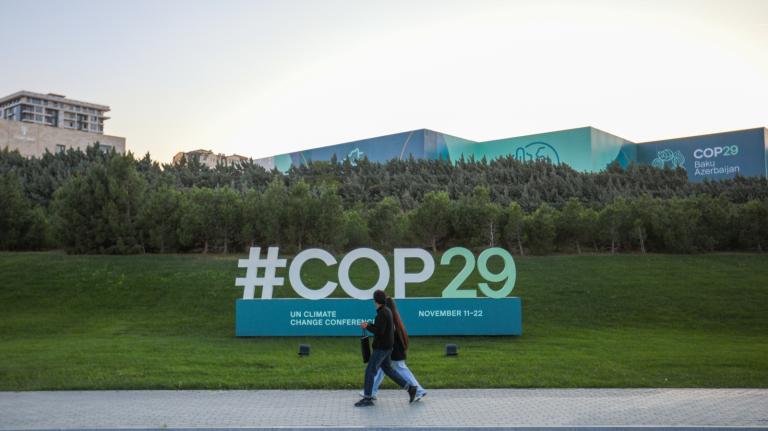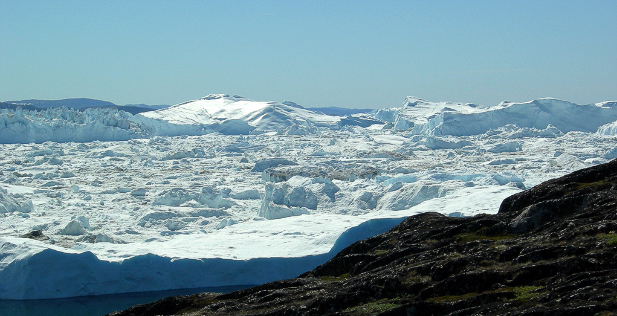 The Sermeq Kujalleq glacier (also known as the Jakobshavn Glacier) near where it flows into the sea in western Greeland. The photo was taken in the summer of 2008. Scientists have recorded the glacier’s rapid melt over the past decade.Courtesy kriskaer via Flickr
The Sermeq Kujalleq glacier (also known as the Jakobshavn Glacier) near where it flows into the sea in western Greeland. The photo was taken in the summer of 2008. Scientists have recorded the glacier’s rapid melt over the past decade.Courtesy kriskaer via Flickr
Here’s a tip for the ministers who are attending the latest of the long series of meetings preparing for the make-or-break climate negotiations in Copenhagen this December.
Go visit the valley of the dogs.
Yes, that’s dogs, not dolls. Greenland sled dogs to be precise. For this week’s meeting of 30 ministers from key countries is in Ilulissat, the third biggest settlement on the immense, increasingly melting island.
They have been invited there for informal “substantive and open” discussions, far from the media, by Connie Hedegaard the impressive Danish Minister for Climate and Energy. She has been holding such ministerial dialogues in different parts of the world for the past five years, but Ilulissat is her prime location, her secret weapon.
A former journalist, she well understands that “seeing is believing.” And in this small coastal town overlooking a sea strewn with icebergs, the evidence of global warming is both unmistakable and overwhelming. She has hosted a whole series of key figures there over the last years, including House Speaker Nancy Pelosi, Sen. John McCain, and German Chancellor Angela Merkel. She wants President Obama to come too.
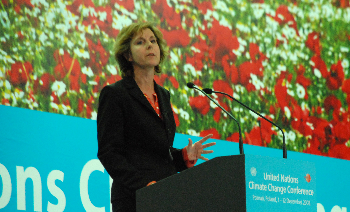 With her country hosting the next major international talks on climate change, Denmark’s Connie Hedegaard has been bringing world leaders to Greenland in hopes that seeing global warming’s effects up close will spur them to action.Courtesy Denmark’s Ministry for Climate and EnergyI was there almost two years ago with Bartholomew I, the Ecumenical Patriarch of the Eastern Orthodox Church. Dubbed “the green pope” for his deep environmental concern, he has held a series of shipboard seminars on religion, science and the environment, on seas and rivers around the world, and this one started just off Ilulissat, home to 4,500 people and 2,500 sled dogs.
With her country hosting the next major international talks on climate change, Denmark’s Connie Hedegaard has been bringing world leaders to Greenland in hopes that seeing global warming’s effects up close will spur them to action.Courtesy Denmark’s Ministry for Climate and EnergyI was there almost two years ago with Bartholomew I, the Ecumenical Patriarch of the Eastern Orthodox Church. Dubbed “the green pope” for his deep environmental concern, he has held a series of shipboard seminars on religion, science and the environment, on seas and rivers around the world, and this one started just off Ilulissat, home to 4,500 people and 2,500 sled dogs.
Ah yes, those dogs. I came across them on a trip ashore, when the whole shipload of us took a walk from the town to an ancient settlement on a nearby shore. In a valley, stretching as far as the eye could see, were countless scratching, sleeping, howling animals, tethered next to makeshift kennels. It must be the strangest settlement of the unemployed on the face of the warming Earth.
Until recently the dogs were busy and treasured, vital engines of transport in a land without roads, where the easiest routes from place to place — or to the best hunting spots — are often across the frozen ocean. But for five years before I was there the sea had failed to freeze, giving the hunters and their dogs nowhere to go.
It is much the same story hundreds of miles away at Qaanaak in the island’s far northwest. The sea still freezes there, but the ice comes one and a half months later than a few years ago, and melts one and a half months earlier. For the local Inuit, who subsist by hunting over the ice with their sleds, it is — as explained to me — “like your boss taking away three months for your pay without giving you notice.”
You can hear the howling of the idle dogs, reputedly descended from wolves, all over Ilulissat. But even this is not the most remarkable, or portentous, sound that fills the air. That sound — loud booms that sometimes rumble like approaching thunder or other times crack sharply like a gunshot — accompanies the calving of yet another iceberg from the giant Sermeq Kujalleq [see map at bottom of next page] glacier reaching the sea just beyond the canine valley.
The booms are ever more frequent these days, for the glacier is melting ever faster as Greenland warms up three times as fast as the rest of the world. Every day it now sheds enough fresh water, in the form of ice, to supply the whole of London or New York for an entire year.
The glacier, the biggest in Greenland, is racing towards the sea at a rate of nearly ten miles a year, five times as fast as a decade ago. And it can go even faster — at one point scientists were shocked to find that part of it had surged three miles in just 90 minutes.
You can see the start of the process if you fly over the glacier. Melt water on the surface is finding its way down to the rock beneath, not in gentle trickles but in giant waterfalls that have carved great caverns in the ice; some are said to be as large as the Niagara Falls.
This has created a lake 500 meters deep under the glacier, lifting the ice and lubricating the glacier’s passage. And much the same is happening all around Greenland, causing its ice-cap to melt far faster than anyone had expected, contributing to the inevitable rising of the world’s seas.
I defy any rational person to see all this and not be struck with the urgency of combatting global warming. The ministers at this week’s climate meeting will surely be shown the glacier; they have been promised “excursions to … view first hand the consequences of climate change.”
Rational people that they are, let’s hope they get the point and act accordingly … and fast.
—
Below: Video of the Ilulissat Icefjord from www.100places.com.
This video is from www.icescapes.tv
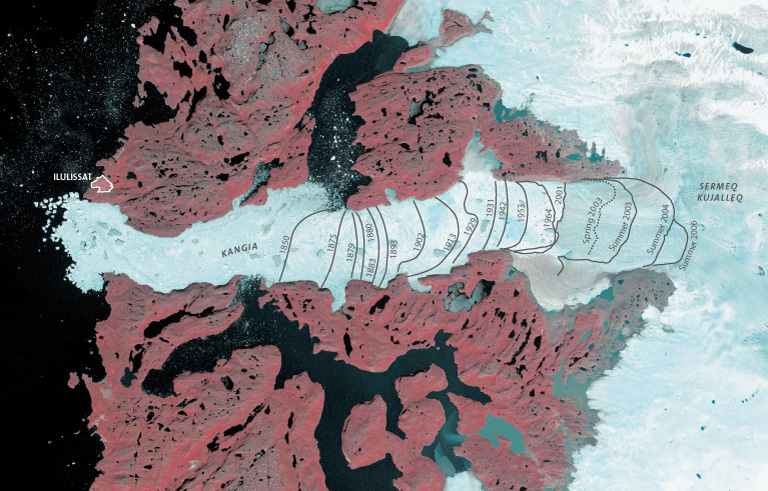 The Jakobshavn Glacier in western Greenland drains the central ice sheet, and it is retreating inland faster than any other. This image shows the glacier in 2001. The glacier flows from upper right to lower left. The fjord beyond the glacier terminus is packed with seasonal ice and icebergs. Terminus locations before 2001 were determined by surveys; more recent contours were derived from Landsat data. Without measurements of ice thickness, however, the picture of ice loss is incomplete. — NASA image by Cindy Starr, based on data from Ole Bennike and Anker Weidick (Geological Survey of Denmark and Greenland) and Landsat data.Courtesy NASA’s Earth Observatory
The Jakobshavn Glacier in western Greenland drains the central ice sheet, and it is retreating inland faster than any other. This image shows the glacier in 2001. The glacier flows from upper right to lower left. The fjord beyond the glacier terminus is packed with seasonal ice and icebergs. Terminus locations before 2001 were determined by surveys; more recent contours were derived from Landsat data. Without measurements of ice thickness, however, the picture of ice loss is incomplete. — NASA image by Cindy Starr, based on data from Ole Bennike and Anker Weidick (Geological Survey of Denmark and Greenland) and Landsat data.Courtesy NASA’s Earth Observatory
